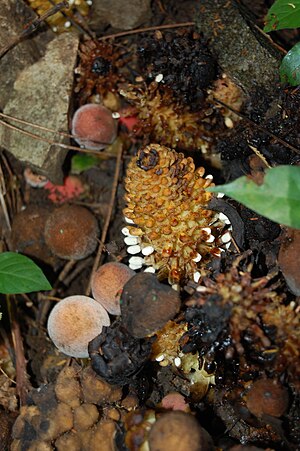Balanophora
| Balanophora | |
|---|---|

| |
| Balanophora fungosa subsp. indica found in northwest Thailand (Hup Patad cave) | |
| Scientific classification | |
| Kingdom: | Plantae |
| Clade: | Tracheophytes |
| Clade: | Angiosperms |
| Clade: | Eudicots |
| Order: | Santalales |
| Family: | Balanophoraceae |
| Genus: | Balanophora J.R.Forst. & G.Forst. |
| Type species | |
| Balanophora fungosa | |
| Species | |
|
See text | |
| Synonyms | |
| |
Balanophora is a genus of parasitic plants in the family Balanophoraceae found in parts of tropical and temperate Asia, including the Eastern Himalayas,[1] Malesia region, Pacific Islands, Madagascar, and tropical Africa.[2][3] There are about 20 accepted species,[4] including the newly discovered B. coralliformis. Many species emit an odour which possibly attracts pollinators in the same way that pollinators are attracted to Rafflesia.[5]
Balanophora species are used in folk medicine in many Asian cultures.[3] For example, in Taiwan and China, Balanophora is known as she-gu (stone-fungus) and in Thailand as hoh-ra-tao-su-nak. In both cases, the plant is used to treat a variety of ailments and has various ritual purposes. The tubers of Balanophora are rich in a wax-like substance which is used in Java as a fuel for torches.[5][6]
Taxonomy
The genus was first described in 1775 by Johann Reinhold Forster and his son Georg Forster in Characteres Generum Plantarum.[7][8] The name is derived from the ancient Greek words balanos (βάλανος), meaning "acorn" and pherein (φέρειν), meaning "to carry".[9]
Species
As of June 2022[update], the following species are accepted at Plants of the World Online:[4]
- Balanophora abbreviata Blume
- Balanophora aphylla Luu, H.Ð.Trần & H.C.Nguyen
- Balanophora coralliformis Barcelona, Tandang & Pelser
- Balanophora cucphuongensis Ban
- Balanophora dioica R.Br. ex Royle
- Balanophora elongata Blume
- Balanophora fargesii (Tiegh.) Harms
- Balanophora flava (Hook.f.) Lidén
- Balanophora fungosa J.R.Forst. & G.Forst. (type species)
- Balanophora harlandii Hook.f.
- Balanophora involucrata Hook.f. & Thomson
- Balanophora japonica Makino
- Balanophora latisepala (Tiegh.) Lecomte
- Balanophora laxiflora Hemsl.
- Balanophora lowii Hook.f.
- Balanophora nipponica Makino
- Balanophora papuana Schltr.
- Balanophora polyandra Griff.
- Balanophora reflexa Becc.
- Balanophora subcupularis P.C.Tam
- Balanophora tobiracola Makino
- Balanophora wilderi Setch.
- Balanophora yakushimensis Hatus. & Masam.
References
- ^ O'Neill, Alexander; Rana, Santosh (26 July 2018). "Root holoparasite Balanophora polyandra Griff. (Balanophoraceae) in eastern Himalaya (Sikkim, India): distribution, range, status and threats". Journal of Threatened Taxa. 10 (8): 12123–12129. doi:10.11609/jott.3644.10.8.12123-12129.
- ^ "Balanophora J.R. Forst. & G. Forst". Tropicos.org.Missouri Botanical Garden. Retrieved 26 January 2015.
- ^ a b O'Neill, A.R.; Rana, S.K. (2019). "An ethnobotanical analysis of parasitic plants (Parijibi) in the Nepal Himalaya". Journal of Ethnobiology and Ethnomedicine. 12 (14). doi:10.1186/s13002-016-0086-y.
- ^ a b "Search results for Balanophora". The Plant List. Retrieved 26 May 2020.
- ^ a b Jin, Chee Beng; Hoo, Lau Kah (2010). "Balanophora:the hidden highland parasite with unexplored medicinal potential". Malaysian Naturalist: 20–21. Retrieved 30 March 2017.
- ^ "Balanophoraceae". Flora Malesiana. Retrieved 30 March 2017.
- ^ "Plant name details". International Plant Names Index (IPNI). Royal Botanic Gardens, Kew; Harvard University Herbaria & Libraries; Australian National Botanic Gardens. Retrieved 22 April 2016.
- ^ Forster, Johann Reinhold; Forster, Georg (1775). Characteres Generum Plantarum. London: White, Cadell & Elmsly. p. 99. Retrieved 22 April 2016.
- ^ Backer, C.A. (1936). Verklarend woordenboek der wetenschappelijke namen van de in Nederland en Nederlandsch-Indië in het wild groeiende en in tuinen en parken gekweekte varens en hoogere planten (Edition Nicoline van der Sijs).
Error: "Q8240497" is not a valid Wikidata entity ID.
- Articles with short description
- Use dmy dates from October 2015
- Use Australian English from March 2017
- All Wikipedia articles written in Australian English
- Articles with 'species' microformats
- Articles containing Ancient Greek (to 1453)-language text
- Articles containing potentially dated statements from June 2022
- All articles containing potentially dated statements
- Taxonbars desynced from Wikidata
- Taxonbar pages requiring a Wikidata item
- Taxonbars with invalid from parameters
- Taxonbars without secondary Wikidata taxon IDs
- Balanophora
- Santalales genera
- All stub articles
- Santalales stubs